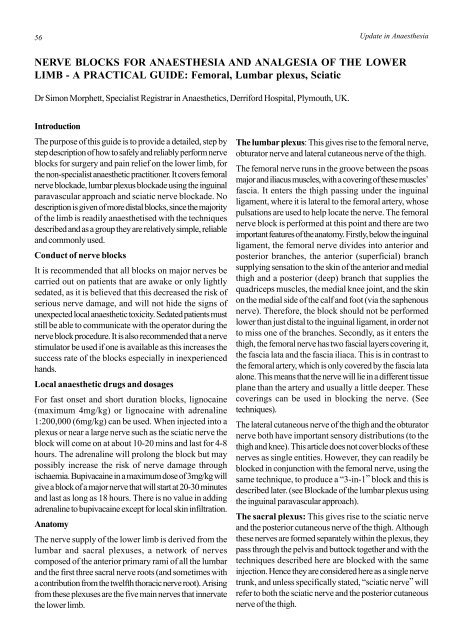Download Update 11 - Update in Anaesthesia - WFSA
Download Update 11 - Update in Anaesthesia - WFSA
Download Update 11 - Update in Anaesthesia - WFSA
Create successful ePaper yourself
Turn your PDF publications into a flip-book with our unique Google optimized e-Paper software.
56<strong>Update</strong> <strong>in</strong> <strong>Anaesthesia</strong>NERVE BLOCKS FOR ANAESTHESIA AND ANALGESIA OF THE LOWERLIMB - A PRACTICAL GUIDE: Femoral, Lumbar plexus, SciaticDr Simon Morphett, Specialist Registrar <strong>in</strong> Anaesthetics, Derriford Hospital, Plymouth, UK.IntroductionThe purpose of this guide is to provide a detailed, step bystep description of how to safely and reliably perform nerveblocks for surgery and pa<strong>in</strong> relief on the lower limb, forthe non-specialist anaesthetic practitioner. It covers femoralnerve blockade, lumbar plexus blockade us<strong>in</strong>g the <strong>in</strong>gu<strong>in</strong>alparavascular approach and sciatic nerve blockade. Nodescription is given of more distal blocks, s<strong>in</strong>ce the majorityof the limb is readily anaesthetised with the techniquesdescribed and as a group they are relatively simple, reliableand commonly used.Conduct of nerve blocksIt is recommended that all blocks on major nerves becarried out on patients that are awake or only lightlysedated, as it is believed that this decreased the risk ofserious nerve damage, and will not hide the signs ofunexpected local anaesthetic toxicity. Sedated patients muststill be able to communicate with the operator dur<strong>in</strong>g thenerve block procedure. It is also recommended that a nervestimulator be used if one is available as this <strong>in</strong>creases thesuccess rate of the blocks especially <strong>in</strong> <strong>in</strong>experiencedhands.Local anaesthetic drugs and dosagesFor fast onset and short duration blocks, lignoca<strong>in</strong>e(maximum 4mg/kg) or lignoca<strong>in</strong>e with adrenal<strong>in</strong>e1:200,000 (6mg/kg) can be used. When <strong>in</strong>jected <strong>in</strong>to aplexus or near a large nerve such as the sciatic nerve theblock will come on at about 10-20 m<strong>in</strong>s and last for 4-8hours. The adrenal<strong>in</strong>e will prolong the block but maypossibly <strong>in</strong>crease the risk of nerve damage throughischaemia. Bupivaca<strong>in</strong>e <strong>in</strong> a maximum dose of 3mg/kg willgive a block of a major nerve that will start at 20-30 m<strong>in</strong>utesand last as long as 18 hours. There is no value <strong>in</strong> add<strong>in</strong>gadrenal<strong>in</strong>e to bupivaca<strong>in</strong>e except for local sk<strong>in</strong> <strong>in</strong>filtration.AnatomyThe nerve supply of the lower limb is derived from thelumbar and sacral plexuses, a network of nervescomposed of the anterior primary rami of all the lumbarand the first three sacral nerve roots (and sometimes witha contribution from the twelfth thoracic nerve root). Aris<strong>in</strong>gfrom these plexuses are the five ma<strong>in</strong> nerves that <strong>in</strong>nervatethe lower limb.The lumbar plexus: This gives rise to the femoral nerve,obturator nerve and lateral cutaneous nerve of the thigh.The femoral nerve runs <strong>in</strong> the groove between the psoasmajor and iliacus muscles, with a cover<strong>in</strong>g of these muscles’fascia. It enters the thigh pass<strong>in</strong>g under the <strong>in</strong>gu<strong>in</strong>alligament, where it is lateral to the femoral artery, whosepulsations are used to help locate the nerve. The femoralnerve block is performed at this po<strong>in</strong>t and there are twoimportant features of the anatomy. Firstly, below the <strong>in</strong>gu<strong>in</strong>alligament, the femoral nerve divides <strong>in</strong>to anterior andposterior branches, the anterior (superficial) branchsupply<strong>in</strong>g sensation to the sk<strong>in</strong> of the anterior and medialthigh and a posterior (deep) branch that supplies thequadriceps muscles, the medial knee jo<strong>in</strong>t, and the sk<strong>in</strong>on the medial side of the calf and foot (via the saphenousnerve). Therefore, the block should not be performedlower than just distal to the <strong>in</strong>gu<strong>in</strong>al ligament, <strong>in</strong> order notto miss one of the branches. Secondly, as it enters thethigh, the femoral nerve has two fascial layers cover<strong>in</strong>g it,the fascia lata and the fascia iliaca. This is <strong>in</strong> contrast tothe femoral artery, which is only covered by the fascia lataalone. This means that the nerve will lie <strong>in</strong> a different tissueplane than the artery and usually a little deeper. Thesecover<strong>in</strong>gs can be used <strong>in</strong> block<strong>in</strong>g the nerve. (Seetechniques).The lateral cutaneous nerve of the thigh and the obturatornerve both have important sensory distributions (to thethigh and knee). This article does not cover blocks of thesenerves as s<strong>in</strong>gle entities. However, they can readily beblocked <strong>in</strong> conjunction with the femoral nerve, us<strong>in</strong>g thesame technique, to produce a “3-<strong>in</strong>-1” block and this isdescribed later. (see Blockade of the lumbar plexus us<strong>in</strong>gthe <strong>in</strong>gu<strong>in</strong>al paravascular approach).The sacral plexus: This gives rise to the sciatic nerveand the posterior cutaneous nerve of the thigh. Althoughthese nerves are formed separately with<strong>in</strong> the plexus, theypass through the pelvis and buttock together and with thetechniques described here are blocked with the same<strong>in</strong>jection. Hence they are considered here as a s<strong>in</strong>gle nervetrunk, and unless specifically stated, “sciatic nerve” willrefer to both the sciatic nerve and the posterior cutaneousnerve of the thigh.
















